Unit 6 电子教案
【精选】人教版七年级上册英语Unit6第六单元优秀教案
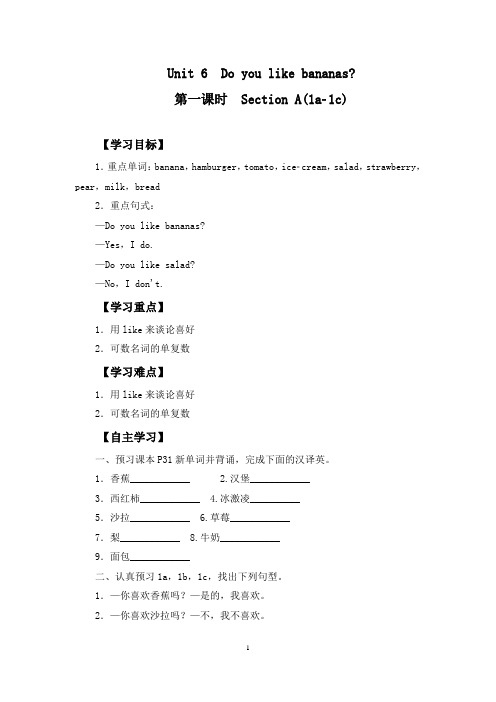
Unit 6 Do you like bananas?第一课时Section A(1a1c)【学习目标】1.重点单词:banana,hamburger,tomato,icecream,salad,strawberry,pear,milk,bread2.重点句式:—Do you like bananas?—Yes,I do.—Do you like salad?—No,I don't.【学习重点】1.用like来谈论喜好2.可数名词的单复数【学习难点】1.用like来谈论喜好2.可数名词的单复数【自主学习】一、预习课本P31新单词并背诵,完成下面的汉译英。
1.香蕉____________ 2.汉堡____________3.西红柿____________ 4.冰激凌__________5.沙拉____________ 6.草莓____________7.梨____________ 8.牛奶____________9.面包____________二、认真预习1a,1b,1c,找出下列句型。
1.—你喜欢香蕉吗?—是的,我喜欢。
2.—你喜欢沙拉吗?—不,我不喜欢。
【课堂导学】Step 1情景导入Teacher:There are many different kinds of fruits and vegetables in the world,and different people like different food.Everyone has its own taste.What kind of food do you like?What kind of food do you dislike?Today let's talk about the food we like and we dislike in Unit 6.环节说明:由学生感兴趣的话题导入新课,简洁明了,激起学生的学习兴趣。
新编实用英语教案unit-6
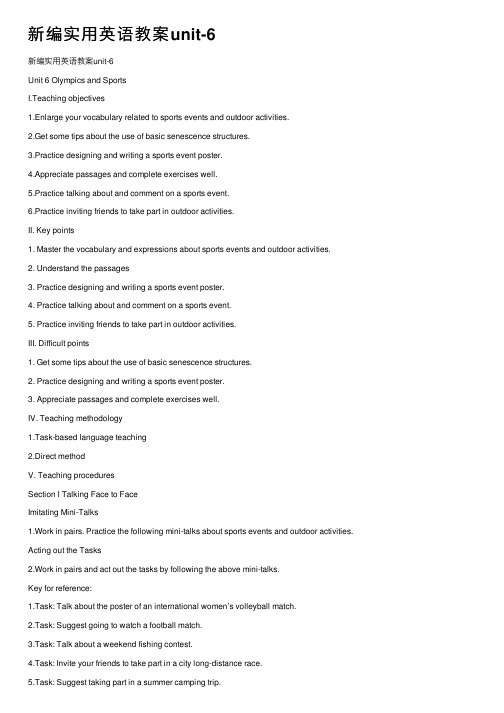
新编实⽤英语教案unit-6新编实⽤英语教案unit-6Unit 6 Olympics and SportsI.Teaching objectives1.Enlarge your vocabulary related to sports events and outdoor activities.2.Get some tips about the use of basic senescence structures.3.Practice designing and writing a sports event poster.4.Appreciate passages and complete exercises well.5.Practice talking about and comment on a sports event.6.Practice inviting friends to take part in outdoor activities.II. Key points1. Master the vocabulary and expressions about sports events and outdoor activities.2. Understand the passages3. Practice designing and writing a sports event poster.4. Practice talking about and comment on a sports event.5. Practice inviting friends to take part in outdoor activities.III. Difficult points1. Get some tips about the use of basic senescence structures.2. Practice designing and writing a sports event poster.3. Appreciate passages and complete exercises well.IV. Teaching methodology1.Task-based language teaching2.Direct methodV. Teaching proceduresSection I Talking Face to FaceImitating Mini-Talks1.Work in pairs. Practice the following mini-talks about sports events and outdoor activities. Acting out the Tasks2.Work in pairs and act out the tasks by following the above mini-talks.Key for reference:1.Task: Talk about the poster of an international women’s volleyball match.2.Task: Suggest going to watch a football match.3.Task: Talk about a weekend fishing contest.4.Task: Invite your friends to take part in a city long-distance race.5.Task: Suggest taking part in a summer camping trip.Studying Posters, Notices and Announcements3.Posters and notices for sports are common in newspapers, on campus and no notice boards. Read the following posters carefully and try to use the information to practice short dialogues.Following Sample Dialogues4.Read the following sample dialogues and try to perform your own tasks.Putting Language to Use5.Imagine you are meeting an English teacher from the USA at the airport. Read aloud the following dialogue with your partner by putting in the missing words.6.Imagine you are a new employee at a joint venture. Mr. Smith is the general manager there. You meet him for the first time at the company’s canteen. Fill in the blanks according to the clues given in the brackets. Then act it out with your partner. Section II Being All EarsLearning Sentences for Workplace Communication1.Listen to 10 sentences for workplace communication cross-referenced with their Chinese translations.Script: (e.g) 1. Haven’t you seen the poster of a weekend cycling?2. That’ll be a great way to kill the weekend.3. Are you going to watch the swimming meet?4. That’ll surely be a close game.5. There is going to be a chess game at the Students’Center this Saturday.2.Listen to the following sentences for workplace communication in Column A and match each one with its Chinese version in Column B.3.Listen to 6 sentences for workplace communication and choose their right responses. Handling a Dialogue4.Listen to a dialogue and decode the message by finding out the correct choices in the brackets according to what you have heard.Understanding a Short Speech/Talk5.Now listen to a short speech/talk and fill up the blanks according to what you have heard.The words in brackets will give you some hints.6.Listen to the speech/talk again and complete the information in Column A with the right choices in Column B.Section III Trying Your HandPracticing Applied Writing1.Read the following two sample announcements/posters and learn to write your own.2.Translate the following poster into Chinese, using the data bank in the Workbook for reference.3.Write an English poster according to the information given in Chinese.4.Write an English poster according to the information given in Chinese.Writing Sentences and Reviewing Grammar5.Put in the proper tense form of the verb according to the adverbial or clause in each of the sentences.6.Correct the errors in the following sentences.7.Translate the following sentences into English.1)There will be an excellent tennis match tomorrow. I have got the tickets already.2)Xiao Li told me that he had taken part in the tug-of-war match that afternoon.3) A modern gymnasium will have been built at our university by this time next year.4)When / while the sportsmen were swimming, we were cheering for them loudly.5)Sports do a lot of good to the health. So I have been doing exercise since I wasyoung.Write and Describe a Picture8. Write a short passage of about 100 words to tell a story or about an event related to the picture given below. Some useful words and phrases have been provided to help you. You may start the passage with the sentence: Fishing is my favorite sport.Section IV Maintaining a Sharp EyePassage oneInformation Related to the Reading Passage/doc/88145c5d4631b90d6c85ec3a87c24028915f850a.html nguage Points:A.Explanation of Difficult Sentences1)When the Beijing 2008 Olympic Games emblem “Chinese Seal, Dancing Beijing” was first presented to the International Olympic Committee, the IOC officials all gave it high praise, saying it was the best emblem ever designed.Analysis: This complex sentence is introduced by when-clause, with +ing-clause as the complement to the main clause“the IOC officials all gave it high praise”.2)The Beijing 2008 Olympic Games emblem is filled with Beijing’s hospitality and hopes, and carries the commitment made to the Olympic Movement by a country that has a population of 1.3 billion and by a nation with both ancient civilization and modern culture.Analysis: Note that the word commitment is followed by an attributive with “that was”omitted; a country is followed by an appositive introduced by that, and both a country and a nation are part of by in the passive voice structure.3)“Dancing Beijing” is a symbol of trust and an expression of self confidence, standing for the promise that Beijing—the host city of the Beijing 2008 Olympic Games—has made to the world and to all mankind.Analysis: The host city of the Beijing 2008 Olympic Games is the inserted element, splitting the attributive clause introduced by that.4)Olympic Games function as the stage where heroes are made, records broken and medals earned.Analysis: An attributive introduced by where is used here. Note omission is used in the attributive. The auxiliary verb are is omitted in records broken and medals earned when similar structures occur on the run.5)The open arms in the emblem say that China is opening its arms to welcome the rest of the world to join the Olympics, a celebration of “peace, friendship and progress of mankind”.Analysis: a celebration of “peace, friendship and progress of mankind”is the appositive of the Olympics.6)“is it not a joy to have friends come from afar?”Analysis: this is a quote from Confucius.7)Come to Beijing, take a good look at the historical heritages of China’s capital city, and feel the pulse of the country’s modernization.Analysis: Imperative structure verb + verb + and verb is used here to encourage people to do something.B.Important Words1)present v.give or hand over something to somebody2)hospitality n. friendly and generous reception and entertainment of guests or strangers, esp. in one’s own home3)commitment n.things one has promised to do; pledge4)intensively ad.Concentrating all one’s effort on a specific area5)passion n. strong feeling, eg. Of hate, love or anger6)symbolize v. be a symbol of something7)represent v.stand for8)vitality n.persistent energy; liveliness or vigor9)historical a.concerning past events2.Passage Translation3.Read and Think: Answer the following questions according to the passage.4.Read and Complete1)Complete each of the following statements with words or phrases from the passage.2)Fill in the blanks with the proper words or expressions given below, changing theform if necessary.5.Read and Translate6.Read and SimulatePassage twoInformation Related to the Reading Passage/doc/88145c5d4631b90d6c85ec3a87c24028915f850a.html nguage Points:A.Explanation of Difficult Sentences1)Tonight, we come to the end of 16 glorious days which we will cherish forever. Analysis: which introduces a relative clause. Note in translation, the sentence is cut into two separate parts.2)Thank-you to the people of China, all the wonderful volunteers and BOCOG! Analysis: This is an elliptical sentence, the full sentence will be “I would like to say thank-you to…”. In speeches, another commonly used sentence expressing thanks is (my) thanks goes to…3)As we celebrate the success of these Games, let us all together wish the best for the talented athletes who will soon participate in the Paralympics Games.Analysis: As introduces an adverbial of time, meaning when. Wish the best for sb. means.4) The Olympic spirit lives in the warm embrace of competitive rivals from nations in conflict.Analysis: The prepositional phrase in conflict is the post modifier of nations, meaning those nation are not on a peaceful and friendly terms.B. Important Words1)cherish v. hold dear2)awe v. inspire with wonder3)talent n. a special aptitude or faculty4)marvel n. feel and show great surprise or wonder (followed by at or that-clause)5)witness v. see something happen6)competitive a. involving in competition7)exceptional a. involving in competition8)assemble v. gather together, collect2.Passage Translation3.Read and Judge: True/False4.Read and Translate: Translate the following sentences into Chinese.1)Every July, graduates come to the end of their college life, which they will cherishforever.2)The Internet offers people more chances of learning about the world.3)Now, in accordance with tradition, I declare the Winter Olympic Games open!4)She has been reading all the necessary information ever since in order to be able toparticipate in that project.5)The group awed us with their talent, teamwork and achievement.6)Every year CCTV chooses “Moving China Top Ten” as the true role models fromacross the whole nation.7)The past two decades have witnessed great changes in information technology. Section V Appreciating Culture Tip (Open)。
人教PEP六年级英语上册 Unit 6 单元教案 (含教学反思)1

Unit 6 How do you feel?Part A教学内容Let's learn,Write and say,Let's try,Let's talk教学目标【知识目标】1.四会词汇:angry,afraid,sad,worried,happy2.三会词汇:chase,mice,bad,hurt,ill3.重点句子:They're afraid of him.The cat is angry with them.【能力目标】1.能够听、说、读、写几个有关情绪的(四会)词汇,能够听、说、认读三会词汇2.能够正确使用“be+表示情绪的形容词”描述自己或他人的情绪。
【情感目标】引导学生关心周围人的感受,做一个体贴友善的人。
教学重点几个表情绪的四会单词。
教学难点正确使用介词with和of。
教学准备课件、录音机和磁带(或其他课本配套音频设备)、人物表情卡片、动画片片段等课时安排2课时第一课时教学过程批注第二课时pictures make you feel?”作业设计1.熟读课文。
2.自主预习B部分Let's learn的新课文。
板书设计be afraid ofbe angry with这个部分主要学习的是有关人物情绪的表达方式,教学的时候用图片和视频展示,学生更容易理解,并且更乐于接受。
Part B教学内容Let's learn,Play card games,Let's try,Let's talk,Read and write,Tips for pronunciation,Let's check,Let's wrap it up教学目标【知识目标】1.四会词汇:see a doctor, wear, more, deep, breath, take a deep breath,count, count to ten2.三会词汇:wrong, should, feel, well,sit, grass, hear, ant, worry, stuck,mud, pull, everyone3.重点句型:You should… Don't be…【能力目标】1.能够正确使用重点单词和词组提供建议。
凤凰职教第三册unit6电子教案
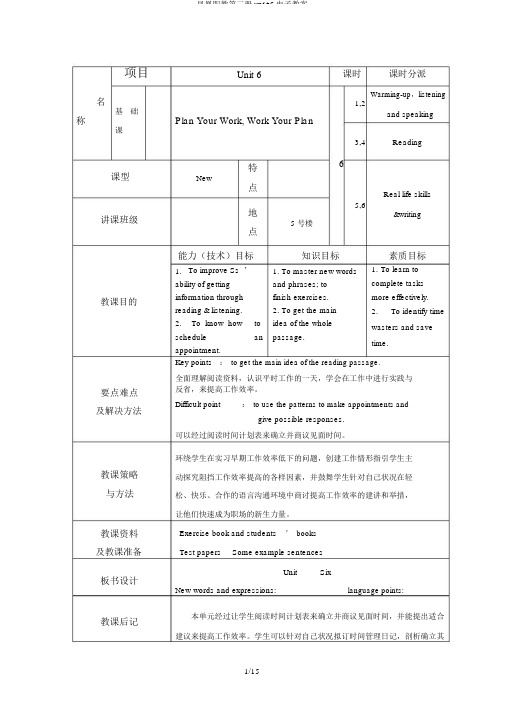
项目名基础称课课型讲课班级Unit 6 课时课时分派1,2Warming-up,listeningand speaking Plan Your Work, Work Your Plan3,4 Reading特 6New点Real life skills5,6地&writing5 号楼点能力(技术)目标知识目标素质目标教课目的1. To improve Ss ’ 1. To master new wordsability of getting and phrases; toinformation through finish exercises.reading & listening. 2. To get the main2. To know how to idea of the wholeschedule an passage.appointment.1.To learn tocomplete tasksmore effectively.2.To identify timewasters and savetime.要点难点及解决方法教课策略与方法教课资料及教课准备板书设计教课后记Key points:to get the main idea of the reading passage.全面理解阅读资料,认识平时工作的一天,学会在工作中进行实践与反省,来提高工作效率。
Difficult point:to use the patterns to make appointments andgive possible responses.可以经过阅读时间计划表来确立并商议见面时间。
环绕学生在实习早期工作效率低下的问题,创建工作情形指引学生主动探究阻挡工作效率提高的各样因素,并鼓舞学生针对自己状况在轻松、快乐、合作的语言沟通环境中商讨提高工作效率的建讲和举措,让他们快速成为职场的新生力量。
Unit6-the-Internet教案

目标测评
15
6
课堂小结
3
7
布置作业
2
8
其它
3
教 学 步 骤
组织教学检查学生出勤情况
课前进入教室,安排班长帮助老师准备好多媒体教学设备,并检查学生学习用品准备情况,检查出勤情况,对请假同学作好记录。上课时间到,如有迟到同学作好记录,问清原因,看情况做好说教工作。
导入
展示目标
问候全体同学.幻灯呈现一个folder。Teacher says,“There is a word in the ’s a kind of thing that we can do a lot of things on as going shopping,making friends,reading books,listening to music,watching movies,playing games.
What is itDo you know?Guess, can help us study and ’s good and it’s also bad.
目
标
达
成
目
标
达
成
授课过程
学生
活动
设计意图
一、导入新课、明确学习目标
1. 呈现课题
板书Unit6the Internet
Lesson21
T:I’m almost on the Internet every day.
renew /r?'nju?/ v. 更新
input /'?np?t/ v. 输入
automatic /??t?'m?t?k/ adj. 自动的
consider /k?n's?d?/ v. 认为
人教版五年级上册英语Unit6《InaNaturePark》教案
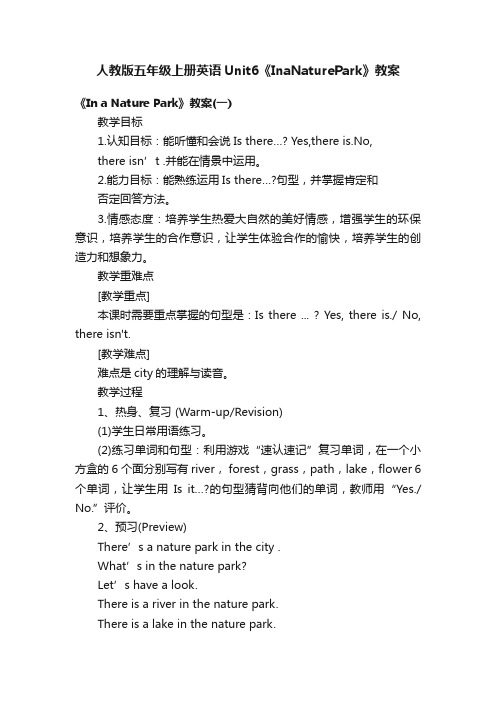
人教版五年级上册英语Unit6《InaNaturePark》教案《In a Nature Park》教案(一)教学目标1.认知目标:能听懂和会说Is there…? Yes,there is.No,there isn’t .并能在情景中运用。
2.能力目标:能熟练运用Is there…?句型,并掌握肯定和否定回答方法。
3.情感态度:培养学生热爱大自然的美好情感,增强学生的环保意识,培养学生的合作意识,让学生体验合作的愉快,培养学生的创造力和想象力。
教学重难点[教学重点]本课时需要重点掌握的句型是:Is there ... ? Yes, there is./ No, there isn't.[教学难点]难点是city的理解与读音。
教学过程1、热身、复习 (Warm-up/Revision)(1)学生日常用语练习。
(2)练习单词和句型:利用游戏“速认速记”复习单词,在一个小方盒的6个面分别写有 river, forest,grass,path,lake,flower 6个单词,让学生用Is it…?的句型猜背向他们的单词,教师用“Yes./ No.”评价。
2、预习(Preview)There’s a nature park in the city .What’s in the nature park?Let’s have a look.There is a river in the nature park.There is a lake in the nature park.There is a forest in the nature park.There is a path in the nature park.There are flowersin the nature park.There are grassesin the nature park.There are trees in the nature park.There are mountainsin the nature park.Is there a lake in the nature park?Yes ,there is.Is there a path in thenature park?Yes ,there is .Is there a forest in the nature park?Yes ,there is .Is there a farm in the nature park?No ,there isn’tIs there a mirror in thenature park?No ,there isn’t 。
译林英语六年级上册unit6教案

译林英语六年级上册unit6教案一、教学内容本课教学内容选自译林英语六年级上册Unit 6 An interesting survey。
本节课主要讲述了一项关于人们喜欢动物的调查。
通过调查,学生们了解到不同的人喜欢不同的动物,有的喜欢狗,有的喜欢猫,还有的喜欢兔子等。
教材通过丰富的插图、简单的句子和有趣的对话,引导学生学习并运用一般现在时谈论个人喜好。
二、教学目标1. 能够听懂、说出一般现在时的一般疑问句并做出正确的回答。
2. 能够运用一般现在时描述自己和朋友的喜好。
3. 通过调查活动,培养学生的合作意识和团队精神。
三、教学难点与重点重点:一般现在时的一般疑问句及其回答。
难点:一般现在时态的运用。
四、教具与学具准备教具:PPT、调查表、动物图片等。
学具:笔记本、文具盒等。
五、教学过程1. 热身(5分钟)教师与学生进行简单的英语对话,如问候、询问身体状况等,引导学生进入学习状态。
然后,教师出示一些动物图片,引导学生谈论他们喜欢的动物。
2. 引入(10分钟)教师出示调查表,引导学生分组进行调查,了解同学们喜欢的动物。
学生可以自由选择动物图片,并在调查表上记录自己喜欢的动物。
调查结束后,教师邀请几名学生分享他们的调查结果。
3. 呈现(10分钟)教师通过PPT展示一般现在时的一般疑问句及其回答。
学生跟读并模仿,教师给予表扬和鼓励。
然后,教师邀请学生用一般现在时描述自己和朋友的喜好,学生互相纠正和指导。
4. 练习(10分钟)教师设计一些练习题,如填空、选择题等,让学生巩固一般现在时的一般疑问句及其回答。
学生独立完成练习,教师及时给予反馈和讲解。
5. 应用(10分钟)教师组织学生进行小组活动,让学生用一般现在时编写对话,谈论自己和朋友喜欢的动物。
学生相互交流、合作,教师巡回指导。
活动结束后,教师邀请几组学生展示他们的对话。
六、板书设计板书内容主要包括一般现在时的一般疑问句及其回答。
教师在黑板上书写关键词,如"Do you like?", "Yes, I do./No, I don't."等,以便学生随时查阅和复习。
人教PEP版英语六年级上册Unit 6《How do you feel》教案

人教PEP版英语六年级上册Unit 6《How do you feel》教案一. 教材分析《人教PEP版英语六年级上册Unit 6 How do you feel》这一单元主要让学生掌握关于表达自己和他人的情感的词汇,如happy, sad, excited, angry等。
同时,学生还需要学会用How do you feel?这一句型进行询问。
教材通过简单的对话和情境,让学生在实际语境中感知、理解和运用所学知识。
二. 学情分析六年级的学生已经具备了一定的英语基础,能够听懂并运用一些简单的英语进行交流。
但是,学生在表达复杂情感方面还存在一定的困难,需要通过大量的练习来巩固。
此外,学生对英语学习的兴趣有待提高,教师需要运用多种教学手段激发学生的学习兴趣。
三. 教学目标1.知识目标:学生能够掌握关于表达情感的词汇,如happy, sad,excited, angry等;学生能够用How do you feel?这一句型进行询问和回答。
2.能力目标:学生能够在实际情境中运用所学知识进行交流,提高口语表达能力。
3.情感目标:通过本单元的学习,学生能够学会关爱他人,关注他人的情感需求。
四. 教学重难点1.重点:学生能够掌握关于表达情感的词汇,用How do you feel?这一句型进行询问和回答。
2.难点:学生能够在实际情境中灵活运用所学知识进行交流。
五. 教学方法1.情境教学法:通过创设各种情境,让学生在实际语境中感知、理解和运用所学知识。
2.交际法:鼓励学生进行互动交流,提高口语表达能力。
3.游戏教学法:运用游戏激发学生的学习兴趣,巩固所学知识。
六. 教学准备1.教学课件:制作与本单元主题相关的课件,引导学生进入学习情境。
2.教学道具:准备一些表达情感的道具,如笑脸、哭脸等,辅助学生理解和学习。
3.教学资源:收集一些关于情感的图片、视频等,用于教学展示和讨论。
七. 教学过程1.导入(5分钟)利用课件展示一些情感表情,如笑脸、哭脸等,引导学生谈论不同的情感。
九年级英语第六单元教案Unit-6--When-was-it-invented

九年级英语第六单元教案Unit-6--When-was-it-invented Unit 6 When was it invented?Unit 6 Section A 1 (1a-2d)⼀、教学⽬标:1. 语⾔知识⽬标:1) 能掌握以下单词:heel, scoop, electricity, style, project, pleasure, zipper, daily, website,pioneer, list, mention能掌握以下句型:①—When was the telephone invented? —I think it was invented in 1876.②—What are they used for? —They are used for seeing at night.2) 能谈论物品被发明的时间、发明者,表达某发明的⽤途。
2. 情感态度价值观⽬标:了解⼀些近现代发明的时间及⽤途,激发⾃⼰热爱发明的情感。
培养想象⼒,善于观察事物。
⾯对难题,⽤积极的态度去解决,发挥想象⼒,认识世界,改造世界。
⼆、教学重难点1. 教学重点:1) 本课时的单词、词组和句型,学习运⽤⼀般过去时态的被动语态。
2) 学会询问发明时间及⽤途的基本句型:—When was the telephone invented? —I think it was invented in 1876.—What are they used for? —They are used for seeing at night.2. 教学难点:运⽤⼀般过去时态的被动语态来讨论发明的发明时间及⽤途。
三、教学过程I. Warming up1. 展⽰⼀些近代发明的图⽚与近代发明的发明者,让学⽣们将图⽚与发明者相连。
T: Do you know what these inventions are? S1: It’s a car.S2: It’s a telephone. S3: It’s a television.T: Do you know who these inventors are? S1: Karl BenzS2: Alexander Bell S3: J. L. BairdLet Ss match the inventions and the inventors.Ⅱ. Presentation引导学⽣们学习⼀般过去时态的被动语态结构。
人教版新目标英语七年级上册 Unit 6 教案(共计17页)
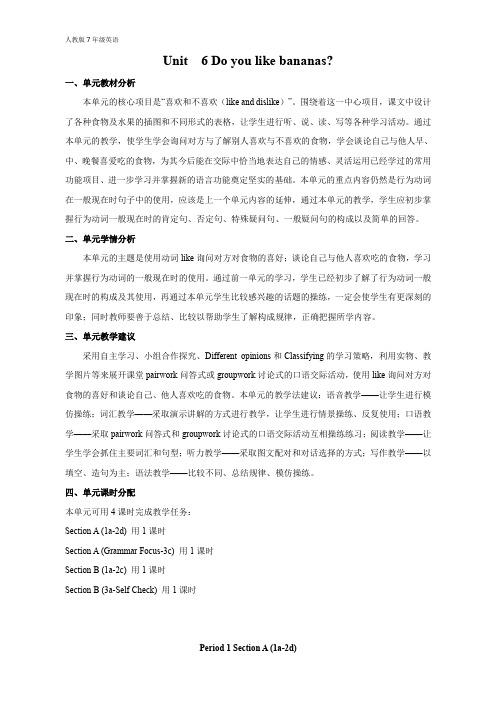
Unit 6 Do you like bananas?一、单元教材分析本单元的核心项目是“喜欢和不喜欢(like and dislike)”。
围绕着这一中心项目,课文中设计了各种食物及水果的插图和不同形式的表格,让学生进行听、说、读、写等各种学习活动。
通过本单元的教学,使学生学会询问对方与了解别人喜欢与不喜欢的食物,学会谈论自己与他人早、中、晚餐喜爱吃的食物,为其今后能在交际中恰当地表达自己的情感、灵活运用已经学过的常用功能项目、进一步学习并掌握新的语言功能奠定坚实的基础。
本单元的重点内容仍然是行为动词在一般现在时句子中的使用,应该是上一个单元内容的延伸,通过本单元的教学,学生应初步掌握行为动词一般现在时的肯定句、否定句、特殊疑问句、一般疑问句的构成以及简单的回答。
二、单元学情分析本单元的主题是使用动词like询问对方对食物的喜好;谈论自己与他人喜欢吃的食物,学习并掌握行为动词的一般现在时的使用。
通过前一单元的学习,学生已经初步了解了行为动词一般现在时的构成及其使用,再通过本单元学生比较感兴趣的话题的操练,一定会使学生有更深刻的印象;同时教师要善于总结、比较以帮助学生了解构成规律,正确把握所学内容。
三、单元教学建议采用自主学习、小组合作探究、Different opinions和Classifying的学习策略,利用实物、教学图片等来展开课堂pairwork问答式或groupwork讨论式的口语交际活动,使用like询问对方对食物的喜好和谈论自己、他人喜欢吃的食物。
本单元的教学法建议:语音教学——让学生进行模仿操练;词汇教学——采取演示讲解的方式进行教学,让学生进行情景操练、反复使用;口语教学——采取pairwork问答式和groupwork讨论式的口语交际活动互相操练练习;阅读教学——让学生学会抓住主要词汇和句型;听力教学——采取图文配对和对话选择的方式;写作教学——以填空、造句为主;语法教学——比较不同、总结规律、模仿操练。
Materials电子教案unit 6
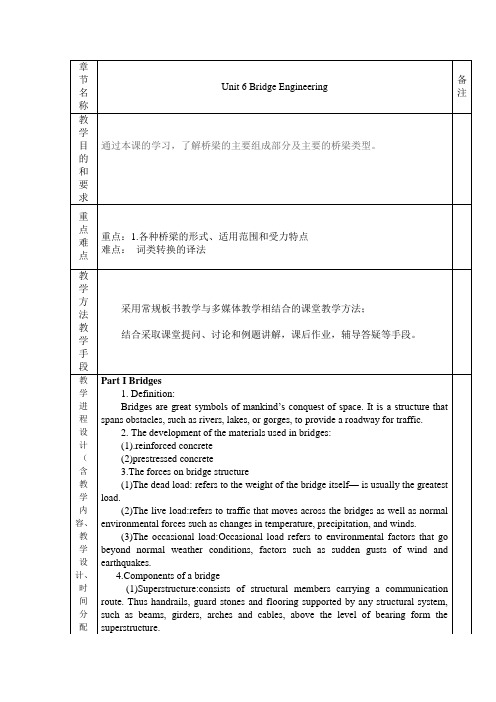
等)(2)Substructure: The portion of the bridge structure below the level of thebearing and above the foundation is generally referred to as substructure. We here mainly explain the substructure of a bridge. The end supports are normally described as the “abutments”, whilst the general term for the intermediate supports of a multi-span bridge is the “piers”. The abutments and piers are usually constructed from in situ concrete, but precast sections can be employed to speed up the construction process.(3)Piers: The general shape and features of a pier depend to a large extent on thetype, size and dimensions of the superstructure and also on the environment in which the pier is located. Piers can be solid, cellular, trestle or hammerhead types.(4)Abutments: An abutment generally consists of the following three distinctstructural elements: (1) the breast wall, which directly supports the dead and live loads of the superstructure, and retains the filling of the embankment in its rear;(2) the wing walls, which act as extensions of the breast wall in retaining the fill though not taking any loads from superstructures; and (3) the back wall, which is a small retaining wall just behind the bridge seat, preventing the flow of material from the fill on to the bridge seat.5.Categories of bridges(1)Girder bridges: A girder bridge is perhaps the most common and most basicbridge. A log or piece of other material across a creek is an example of a girder bridge in its simplest form. That piece of material—called a girder or beam—rests directly on the ground on each side or is supported on heavy foundations known as piers. Girder bridges come in two basic varieties: plate and box girders. Simple or continuous beam-type bridges can be made of timber, steel, concrete, prestressed concrete or other materials.(2)Arch bridges: A strong point in favor of arch bridges in their pleasingappearance and aesthetic elegance. Arch bridges can be made of bricks or stone blocks that are held together by the compressive force characteristic of the arch because tensile strength is not necessarily required for arch construction. Reinforced concrete and steel arches are altogether much lighter structures. The structure consists basically of the arch, the deck and usually some supports from the arch to the deck.(3)Cantilever bridges: A cantilever bridge is a bridge built using cantilevers, acantilever is a structure or beam that is unsupported at one end but supported at the other, like diving boards. When anchored firmly, a cantilever is a very strong structure. It consists of three parts: the outer beams, the cantilever, and the central beam. This configuration made longer spans possible and wider clearance beneath.Among the largest cantilever bridges in the United States is the Commodore Barry Bridge.。
人教pep四年级英语上册unit6教案
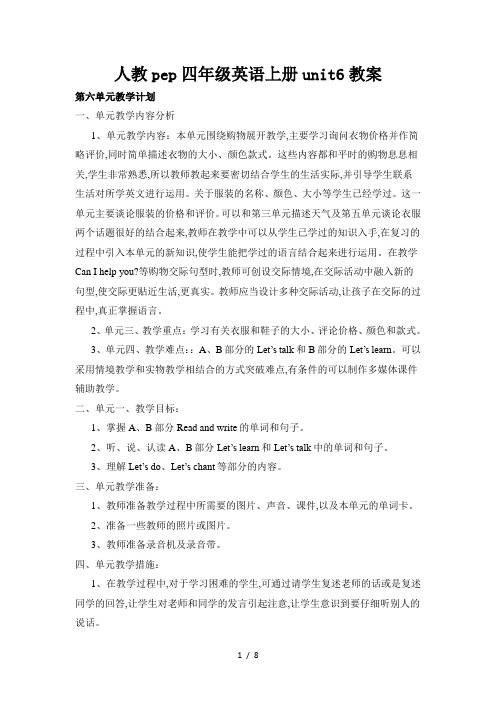
人教pep四年级英语上册unit6教案第六单元教学计划一、单元教学内容分析1、单元教学内容:本单元围绕购物展开教学,主要学习询问衣物价格并作简略评价,同时简单描述衣物的大小、颜色款式。
这些内容都和平时的购物息息相关,学生非常熟悉,所以教师教起来要密切结合学生的生活实际,并引导学生联系生活对所学英文进行运用。
关于服装的名称、颜色、大小等学生已经学过。
这一单元主要谈论服装的价格和评价。
可以和第三单元描述天气及第五单元谈论衣服两个话题很好的结合起来,教师在教学中可以从学生已学过的知识入手,在复习的过程中引入本单元的新知识,使学生能把学过的语言结合起来进行运用。
在教学Can I help you?等购物交际句型时,教师可创设交际情境,在交际活动中融入新的句型,使交际更贴近生活,更真实。
教师应当设计多种交际活动,让孩子在交际的过程中,真正掌握语言。
2、单元三、教学重点:学习有关衣服和鞋子的大小、评论价格、颜色和款式。
3、单元四、教学难点::A、B部分的Let’s talk和B部分的Let’s learn。
可以采用情境教学和实物教学相结合的方式突破难点,有条件的可以制作多媒体课件辅助教学。
二、单元一、教学目标:1、掌握A、B部分Read and write的单词和句子。
2、听、说、认读A、B部分Let’s learn和Let’s talk中的单词和句子。
3、理解Let’s do、Let’s chant等部分的内容。
三、单元教学准备:1、教师准备教学过程中所需要的图片、声音、课件,以及本单元的单词卡。
2、准备一些教师的照片或图片。
3、教师准备录音机及录音带。
四、单元教学措施:1、在教学过程中,对于学习困难的学生,可通过请学生复述老师的话或是复述同学的回答,让学生对老师和同学的发言引起注意,让学生意识到要仔细听别人的说话。
2、对于学习还不错,但是不愿或害怕发言的学生,课堂中教师主动请他们表达其意见,培养他们良好的学习英语的习惯。
汽车专业英语电子教案 6
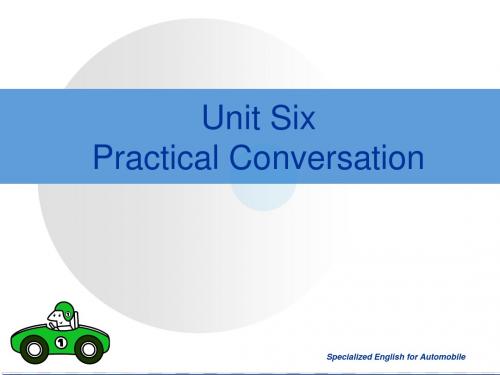
Vocabulary and Terminology
1. calm and steady 稳重的 His tone sounds calm and steady 他的声音听起来很稳重。 2. spacious [ speiʃəs] adj. 宽敞的 The interior of the car was very spacious. 这部车的内部空间非常宽敞。 3. stereo system 音响 Your stereo system must be of the best quality. 你的音响一定是品质最好的。
Salesman: The engine’s maximum power is 150 KW at 5,000 rpm. The engine is a 3.0L six cylinder 24-valve model. The fuel consumption is 6.5L /100km on the highway and 12 L /100km in the city. Customer: How much does it cost? Salesman: The price is 250,000 yuan. We’ll offer the preferential service on right now, such as discount 9.5, free waxing once, handling the insurance business of compensation etc. Customer: Thank you. Please give me your name card. Salesman: No problem. Call me any time if you need any help. Customer: OK! I will think it over and let you know my decision soon. Good bye! Salesman: Good bye!
人教版九年级英语Unit 6 When was it invented。全单元教案
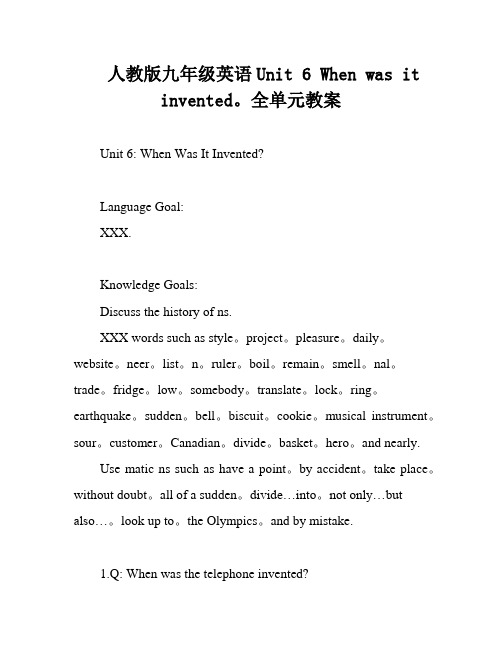
人教版九年级英语Unit 6 When was itinvented。
全单元教案Unit 6: When Was It Invented?Language Goal:XXX.Knowledge Goals:Discuss the history of ns.XXX words such as style。
project。
pleasure。
daily。
website。
neer。
list。
n。
ruler。
boil。
remain。
smell。
nal。
trade。
fridge。
low。
somebody。
translate。
lock。
ring。
earthquake。
sudden。
bell。
biscuit。
cookie。
musical instrument。
sour。
customer。
Canadian。
divide。
basket。
hero。
and nearly.Use matic ns such as have a point。
by accident。
take place。
without doubt。
all of a sudden。
divide…into。
not only…but also…。
look up to。
the Olympics。
and by mistake.1.Q: When was the telephone invented?A: I believe it was invented in 1876 by Alexander Graham Bell.2.Q: Was the TV invented before or after the car?A: There is some doubt about this。
but it is generally accepted that the car was invented before the TV.3.Q: Who invented the zipper?A: XXX XXX.4.Q: What is a hot ice-cream scoop used for?A: A hot ice-cream scoop is used for serving really cold ice-cream.5.XXX was invented by Alexander Graham Bell in 1876.Passive voice can be used to talk about ns。
七年级下册英语Unit6单元教案(人教版)

书
设
计
Unit6 I’m watching TV
重点语法
现在进行时的用法:
What are you doing?
I’m reading a newspaper.
What is he doing?
He is using the computer
教
学
反
思
学校教师备课笔记
年级
七年级
学科
英语
主备教师
复备教师
教
学
目
标
1.能够熟练掌握并学会运用重点词汇和短语。
2.能用现在进行时描述正在发生的动作
3.能把所学只是用到实际生活中,激发学生学习兴趣
教学重点难点
1.学习询问和谈论彼此的能力和特长
2.情态动词can的构成和使用
教学方法
Speaking Method、WritingMethod
课前准备
教师
做好本单元课件
通过对话轻松地过渡到本课话题上来
教学
环节
教学活动
设计意图
(或复备建议)
帮助学生掌握短语的灵活运用
I think survey is so important that the students should speak as much as they can in class or after class.
教师活动
学生活动
Step2
Step3
Step 4
Presentation
通过幻灯片复习、学习本课时所用到的重要短语:watch tv, clean, use the computer等
1b .Listening
1. Make sure the Ss know whattodo .Give them an example orally if possible .
人教版八年级下册英语Unit6(第六单元)优秀教案
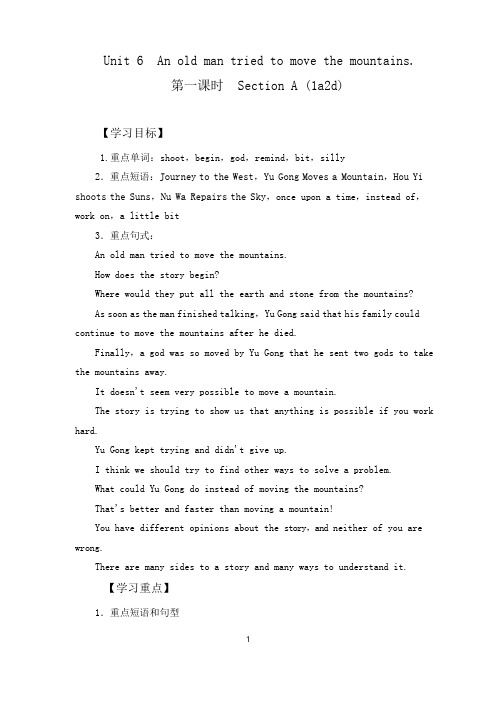
Unit6An old man tried to move the mountains.第一课时Section A(1a2d)【学习目标】1.重点单词:shoot,begin,god,remind,bit,silly2.重点短语:Journey to the West,Yu Gong Moves a Mountain,Hou Yi shoots the Suns,Nu Wa Repairs the Sky,once upon a time,instead of,work on,a little bit3.重点句式:An old man tried to move the mountains.How does the story begin?Where would they put all the earth and stone from the mountains?As soon as the man finished talking,Yu Gong said that his family could continue to move the mountains after he died.Finally,a god was so moved by Yu Gong that he sent two gods to take the mountains away.It doesn't seem very possible to move a mountain.The story is trying to show us that anything is possible if you work hard.Yu Gong kept trying and didn't give up.I think we should try to find other ways to solve a problem.What could Yu Gong do instead of moving the mountains?That's better and faster than moving a mountain!You have different opinions about the story,and neither of you are wrong.There are many sides to a story and many ways to understand it.【学习重点】1.重点短语和句型2.unless,so...that,as soon as...等的用法【学习难点】1.重点短语和句型2.unless,so...that,as soon as...等的用法【自学学习】一、预习课本P4142新单词并背诵,完成下面的汉译英。
unit6-In-a-nature-park-全单元教案
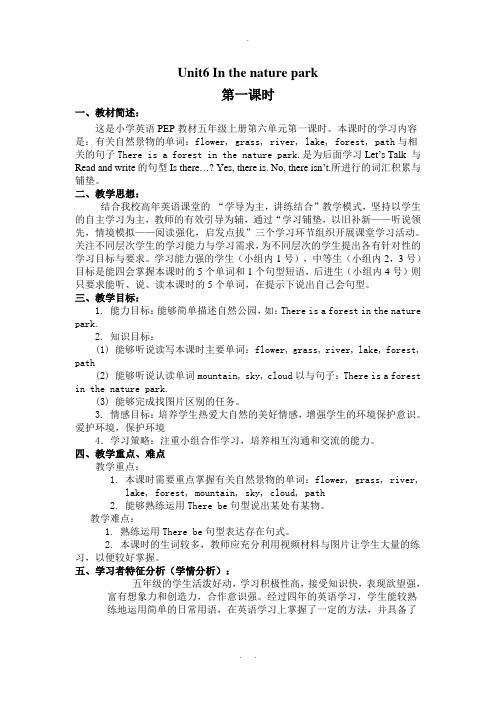
Unit6 In the nature park第一课时一、教材简述:这是小学英语PEP教材五年级上册第六单元第一课时。
本课时的学习内容是:有关自然景物的单词:flower, grass, river, lake, forest, path与相关的句子There is a forest in the nature park.是为后面学习Let’s Talk 与Read and write的句型Is there…? Yes, there is. No, there isn’t.所进行的词汇积累与铺垫。
二、教学思想:结合我校高年英语课堂的“学导为主,讲练结合”教学模式,坚持以学生的自主学习为主,教师的有效引导为辅,通过“学习铺垫,以旧补新——听说领先,情境模拟——阅读强化,启发点拔”三个学习环节组织开展课堂学习活动。
关注不同层次学生的学习能力与学习需求,为不同层次的学生提出各有针对性的学习目标与要求。
学习能力强的学生(小组内1号),中等生(小组内2,3号)目标是能四会掌握本课时的5个单词和1个句型短语,后进生(小组内4号)则只要求能听、说、读本课时的5个单词,在提示下说出自己会句型。
三、教学目标:1. 能力目标:能够简单描述自然公园,如:There is a forest in the nature park.2. 知识目标:(1) 能够听说读写本课时主要单词:flower, grass, river, lake, forest, path(2) 能够听说认读单词mountain, sky, cloud以与句子:There is a forest in the nature park.(3) 能够完成找图片区别的任务。
3. 情感目标:培养学生热爱大自然的美好情感,增强学生的环境保护意识。
爱护环境,保护环境4.学习策略:注重小组合作学习,培养相互沟通和交流的能力。
四、教学重点、难点教学重点:1. 本课时需要重点掌握有关自然景物的单词:flower, grass, river,lake, forest, mountain, sky, cloud, path2. 能够熟练运用There be句型说出某处有某物。
新目标英语九年级unit6教案
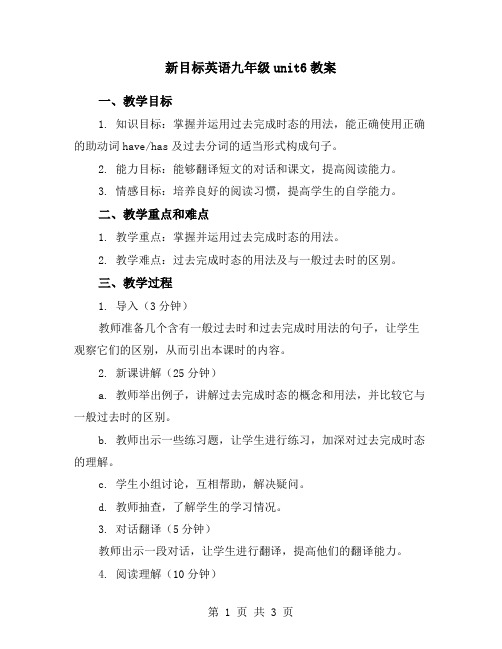
新目标英语九年级unit6教案一、教学目标1. 知识目标:掌握并运用过去完成时态的用法,能正确使用正确的助动词have/has及过去分词的适当形式构成句子。
2. 能力目标:能够翻译短文的对话和课文,提高阅读能力。
3. 情感目标:培养良好的阅读习惯,提高学生的自学能力。
二、教学重点和难点1. 教学重点:掌握并运用过去完成时态的用法。
2. 教学难点:过去完成时态的用法及与一般过去时的区别。
三、教学过程1. 导入(3分钟)教师准备几个含有一般过去时和过去完成时用法的句子,让学生观察它们的区别,从而引出本课时的内容。
2. 新课讲解(25分钟)a. 教师举出例子,讲解过去完成时态的概念和用法,并比较它与一般过去时的区别。
b. 教师出示一些练习题,让学生进行练习,加深对过去完成时态的理解。
c. 学生小组讨论,互相帮助,解决疑问。
d. 教师抽查,了解学生的学习情况。
3. 对话翻译(5分钟)教师出示一段对话,让学生进行翻译,提高他们的翻译能力。
4. 阅读理解(10分钟)教师出示一篇阅读文章,让学生进行阅读,并回答教师提出的问题。
5. 课文理解(15分钟)教师出示课文,让学生进行阅读和理解,并回答教师提出的问题。
同时,教师也要注意纠正学生的语音语调,帮助他们正确地朗读课文。
6. 课后作业(3分钟)教师布置课后作业,包括造句、翻译句子、完成短文等。
7. 课后小结(3分钟)教师对本节课的内容进行总结,帮助学生更好地掌握过去完成时态的用法。
四、课后反思在本节课中,学生应该能够掌握过去完成时态的用法,并能够正确地使用助动词have/has及过去分词构成正确的句子。
为了达到这个目标,教师需要在讲解过程中举例说明,并进行适当的练习。
同时,教师也要注意培养学生的阅读能力和理解能力,帮助他们更好地掌握本课时的内容。
在课后,教师需要进行反思,检查自己的教学效果,并不断改进教学方法,提高教学质量。
五、补充材料为了更好地帮助学生掌握过去完成时态的用法,教师可以提供一些相关的练习题和阅读材料。
- 1、下载文档前请自行甄别文档内容的完整性,平台不提供额外的编辑、内容补充、找答案等附加服务。
- 2、"仅部分预览"的文档,不可在线预览部分如存在完整性等问题,可反馈申请退款(可完整预览的文档不适用该条件!)。
- 3、如文档侵犯您的权益,请联系客服反馈,我们会尽快为您处理(人工客服工作时间:9:00-18:30)。
The experiment cannot be satisfactory because he has to use the random selection of materials.
random
搭配用法
at random 随意,任意
example
The teacher took a book at random from the shelf.
She selected a dress at random in the shop.
come to
(of an idea) to occur to sb. 想出,想到
example
This idea came to him when he was walking.
It suddenly came to her that she had made a mistake.
example
I hope my comments didn’t embarrass you.
Giving my opinion in the public embarrassed me.
embarrassing
a. making you feel nervous, ashamed, or uncomfortable 令人困窘的,令人尴尬的, (通常用来修饰某个事件或者情况)
1.overlooking a nickle in the road 2.consideration about small opportunities 3.her daughter’s example 4.her regrets
Conclusion (Paras. 8-9)
We should take advantage of every opportunity in our daily life.
Seemingly they didn’t know what had happened
otherwise
1. conj. if conditions were different; if not 否则,不然
example
I hope the weather improves. Otherwise we’ll have to cancel(取消)the picnic.
搭配用法
be unworthy of
These people are unworthy of our respect.
This plan is unworthy of our consideration.
weigh on sb/sth
to make anxious ,使…烦恼,使…陷于困境
example
random
a. done, chosen, etc. without method or conscious choice 任意的;随便的;随机的
example When his parents asked him about his study, he just gave a random answer.
They took full advantage of the Internet. She took advantage of Richard to realize her goal.
seemingly
ad. in appearance, apparently 表面上,外观上
example
She was seemingly calm when she left.
搭配用法
1. was determined to be a lawyer. 2.be determined that… I was determined that things like this would never happen again.
You obviously think otherwise.
determined
a. with one’s mind firmly made up 有决心的,意志坚定的
example
She is a strong and determined woman.
China has made a determined effort to reduce population growth.
All tickets are now available at a discount.
payoff
n. an advantage or profit that one gets as a result of doing sth (做某事的) 报偿,得益,收效
example
There will be a big environmental payoff if we use leadfree gas (无铅汽油). His success is a great payoff for his persistence.
example
Ron had to run to keep pace with Guido. He finds it hard to keep pace with all the developments in nuclear physics (核子物理学).
pass sb/sth by
to pay no attention to sb/sth ; disregard 不注意,忽视,使 (某人) 没有从中获益
example
Three buses passed by, but none of them was the right one.
I was just passing by her house, so I thought I’d visit her.
embarrass
v. to cause sb to feel self-conscious, awkward or ashamed 使困窘,使尴尬
round
v. to go around (sth.) 绕过,环绕
example
We rounded the corner at a high speed.
The car had just rounded the corner when it was hit by a truck.
pace
n.1. speed, esp of walking or running 速度(尤指走或跑的) example He slowed his pace to observe where Kate went.
determine
v. to decide firmly that sth. will be done; make up one’s mind about 决定,决心
She determined to learn Greek. We determined on an early start.
搭配用法
example
She looked embarrassed when she fell.
I felt so embarrassed about my mistake.
overlook
v.1. to fail to see or notice; miss 忽视,忽略; 2. to ignore and forgive someone’s mistake, bad behavior etc. 宽恕
discount
1. v. to regard sth as unlikely to be important 不重视,不理会
example
The government should not have discounted the bomb threat in such a tense situation.
Don’t discount the loose change, when added up, they will become a large sum.
2. n. a reduction in the cost of goods you’re buying 折扣,减价
example
Do I get a discount if I buy a whole case of wine?
Unit Six Attitude Towards Life
ENTER
Text Structure Analysis Introduction (Para. 1)
The author tries to get outside and take a walk every day.
The author’s story and her thoughts about the nickle incident. (Paras. 2-7)
determine to do sth./determine on/upon sth
be aware of
having knowledge or realization of sb./sth. 觉察到,意识到
example
I began to be aware of the gravity (严重性) of the situation. Are you aware of the dangers of smoking?
2. rate or progress or development, esp. of an activity 进步 或发展的速度,进展
example
The pace of change increased steadily during the 21st century.
pace
搭配用法
keep pace with sb./sth. 与某人[某物]齐步前进,跟上某人[某物]
example
